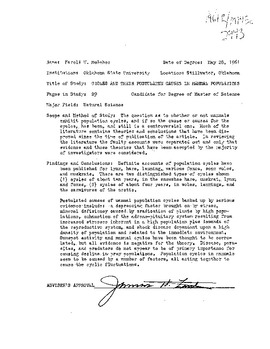| dc.contributor.advisor | Zant, James H. | |
| dc.contributor.author | McGehee, Harold W. | |
| dc.date.accessioned | 2016-02-26T15:28:52Z | |
| dc.date.available | 2016-02-26T15:28:52Z | |
| dc.date.issued | 1961-05 | |
| dc.identifier.uri | https://hdl.handle.net/11244/31900 | |
| dc.description.abstract | Scope and Method of Study: The question as to whether or not mammals exhibit population cycles, and if so the cause or causes for the cycles, has been, and still is a controversial one. Much of the literature contains theories and conclusions that have been disproved since the time of publication of the article. In reviewing the literature the faulty accounts were separated out and only that evidence and those theories that have been, accepted by the majority of investigators were considered. | |
| dc.description.abstract | Findings and Conclusions: Definite accounts of population cycles have been published for lynx, hare, lemming, various foxes, some voles, and muskrats. There are two distinguished types of cycles shown (1) cycles of about ten years, in the snowshoe hare, muskrat, lynx, and foxes, (2) cycles of about four years, in Violas, lemmings, and the carnivores of the arctic. | |
| dc.description.abstract | Postulated causes of mammal population cycles backed up by serious evidence include: a depressing factor brought on by stress, mineral deficiency caused, by eradication of plans by high populations,, exhaustion, of the adreno-pituitary system, resulting from increased stresses inherent in a high population plus demands of the reproductive system, and shock disease dependent upon a high density of population and related to the immediate environment. Sunspot activity and mammal cycles have been thought to be correlated, but all evidence is negative for the theory. Disease, parasites, and predators do not appear to be of primary importance for causing decline in prey populations. Population cycles in mammals seem to be caused-by a number of factors, all acting together to cause the cyclic fluctuations. | |
| dc.format | application/pdf | |
| dc.language | en_US | |
| dc.rights | Copyright is held by the author who has granted the Oklahoma State University Library the non-exclusive right to share this material in its institutional repository. Contact Digital Library Services at lib-dls@okstate.edu or 405-744-9161 for the permission policy on the use, reproduction or distribution of this material. | |
| dc.title | Cycles and their postulated cause in mammal populations | |
| dc.contributor.committeeMember | Bruneau, L. Herbert | |
| osu.filename | Thesis-1961R-M145c.pdf | |
| osu.accesstype | Open Access | |
| dc.type.genre | Master's Report | |
| dc.type.material | Text | |
| thesis.degree.discipline | Natural Science | |
| thesis.degree.grantor | Oklahoma State University | |
